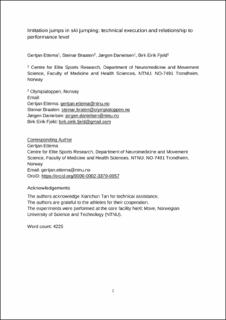| dc.contributor.author | Ettema, Gertjan | |
| dc.contributor.author | Braaten, Steinar | |
| dc.contributor.author | Danielsen, Jørgen | |
| dc.contributor.author | Fjeld, Birk Eirik | |
| dc.date.accessioned | 2022-01-03T10:03:27Z | |
| dc.date.available | 2022-01-03T10:03:27Z | |
| dc.date.created | 2021-02-04T11:57:54Z | |
| dc.date.issued | 2020 | |
| dc.identifier.citation | Journal of Sports Sciences. 2020, 38 (18), 2155-2160. | en_US |
| dc.identifier.issn | 0264-0414 | |
| dc.identifier.uri | https://hdl.handle.net/11250/2835762 | |
| dc.description.abstract | Imitation jumps are frequently used in training for ski jumping. Yet, the dynamics of these jumps differ considerably. Thus, the relevance of imitation jumps for ski jumping performance is not elucidated. The aim of this study was to investigate the relationship between the technical execution of imitation jumps and ski jumping performance level. We compared the imitation jumps of 11 ski jumpers of different performance levels using a Spearman correlation transform of time traces of the kinetics (measured using force cells and motion capture) of imitation jumps. The kinetic aspects that were related to performance centred on the moment arm of ground reaction force to the centre of mass before the onset of the push-off, angular momentum early in push-off, thigh angle during the main period of push-off and vertical velocity towards the end of push-off. We propose that the thigh angle may be a key element allowing high development of linear momentum while preparing for appropriate aerodynamic position. Furthermore, the findings suggest that the kinetic development prior to (and during) push-off is more important than the kinematic end state at take-off. | en_US |
| dc.language.iso | eng | en_US |
| dc.publisher | Taylor and Francis | en_US |
| dc.rights | Navngivelse-Ikkekommersiell 4.0 Internasjonal | * |
| dc.rights.uri | http://creativecommons.org/licenses/by-nc/4.0/deed.no | * |
| dc.title | Imitation jumps in ski jumping: Technical execution and relationship to performance level | en_US |
| dc.type | Peer reviewed | en_US |
| dc.type | Journal article | en_US |
| dc.description.version | acceptedVersion | en_US |
| dc.source.pagenumber | 2155-2160 | en_US |
| dc.source.volume | 38 | en_US |
| dc.source.journal | Journal of Sports Sciences | en_US |
| dc.source.issue | 18 | en_US |
| dc.identifier.doi | 10.1080/02640414.2020.1776913 | |
| dc.identifier.cristin | 1886676 | |
| dc.description.localcode | This is the authors' accepted manuscript to an article published by Taylor & Francis. | en_US |
| cristin.ispublished | true | |
| cristin.fulltext | postprint | |
| cristin.qualitycode | 1 | |

